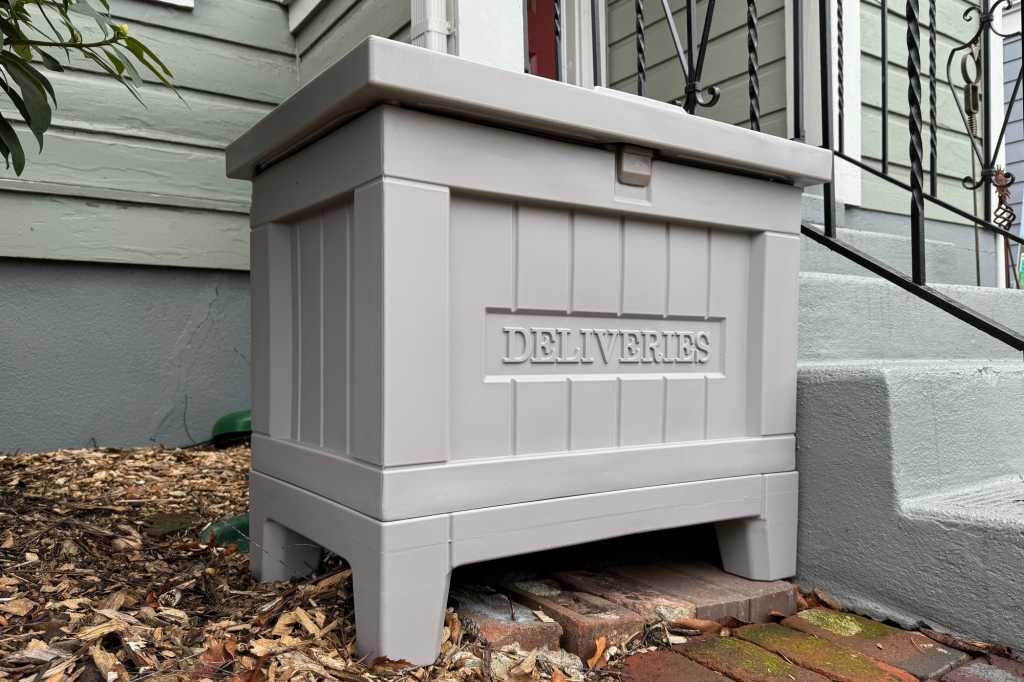Expert’s Rating
Pros
- Bluetooth and Wi-Fi connectivity
- Strong ecosystem support: Alexa, Google Home, Apple HomeKit, and more
- Battery powered
- Floating bottom tray to keep parcels dry
- Hollow bottom can be weighed down with sand
Cons
- Relies on disposable batteries
- Doesn’t support one-time-use PINs for each delivery
- Some assembly required
Our Verdict
If HomeKit support is on your must-have list, the Yale Smart Delivery Box is one of the few products in its class to offer it. Yale smart lock owners, meanwhile, will appreciate not needing to install yet another smartphone app to use it. For everyone else, its shortcomings in other areas outweigh the value of the rest of its features.
Price When Reviewed
$329.99
Best Prices Today: Yale Smart Delivery Box — Kent (with Wi-Fi and keypad)
Anyone who’s tired of dealing with stolen packages—which is to say, everyone—has at least considered solving the problem with a smart delivery box. There are several good ideas in the Yale Smart Delivery Box, but these are ultimately outweighed by its flaws.
Let’s tackle the good ideas first, since you might disagree with my opinion after hearing about them. TechHive being focused on the smart home, I asked Yale to send the version of its Kent model Smart Delivery Box that includes an electronic keypad for opening the box.
The Yale Smart Delivery Box will arrive partially disassembled, but it’s easy enough to put together.
Michael Brown/Foundry
Design and materials
The box itself is fabricated from a plastic resin material. It measures 19.0 x 24.6 Wide x 28 inches (HxWxD) and it can accommodate packages up to 16 inches high. A hinged lid opens far enough to remain open. It doesn’t have a mechanism to keep it open, but you’ll have enough trouble getting couriers to use it—or any delivery box—without depending on them to figure out any other mechanics.
The Yale Smart Delivery Box is a much better product than Genie’s Bench Sentry.
The box comes mostly fully assembled. You’ll still need a Phillips screwdriver, a 1/4-inch Torx screwdriver, and a 1/2-inch socket wrench or nut driver to set it up. An electric drill with a 1/4-inch bit is optional and would be used to drill drain holes in the bottom of the box should water get inside the box. Yale also provides a ridged false bottom that can help keep packages dry. If you have groceries delivered, you can put ice on the very bottom and put this false bottom on top of it to keep the parcels dry. There’s also a third-party cooler insert available for around $20 at Amazon.

You can tether the Yale Smart Delivery Box to something or you can pour sand into these four holes to discourage casual thieves from making off with the whole box.
Michael Brown/Foundry
The footed base is separate from the rest of the box, and the two must be bolted together. There’s a good reason for this: You can choose to pour bulk sand into the base and then cap the four holes provided for this purpose.
You’ll of course need to supply the sand, and you’ll want to place the box in its final resting place before you do that—after which, you’ll need to bolt the two pieces together—but the added weight should discourage at least casual thieves from making off with the entire box. You could also buy a lock-and-cable accessory for even more security (or if you just don’t want to wrestle a 50-pound bag of sand). I couldn’t find the Kwic-Loc & Tether solution Yale advertises, but I did find a similar product at Amazon.
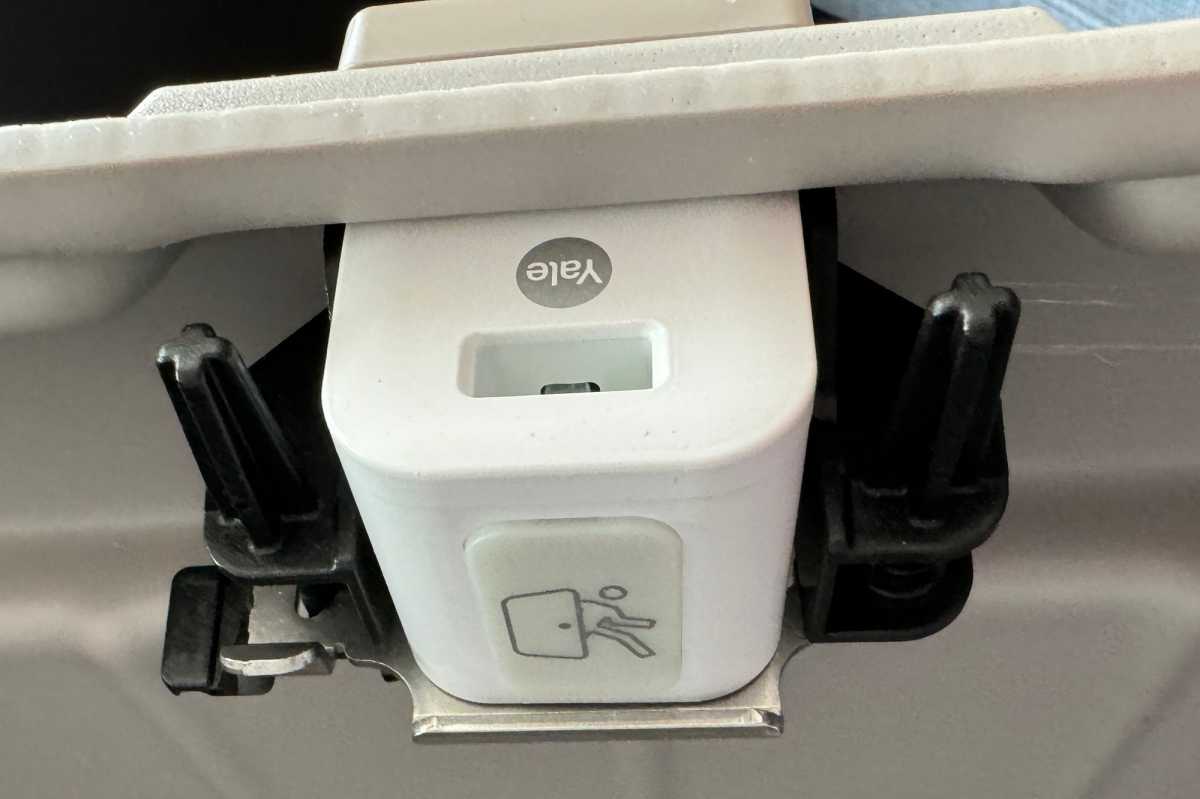
The smart lock inside the Yale Smart Delivery Box has a prominent button that will unlock the box should someone become trapped inside.
Michael Brown/Foundry
The box’s electronic lock comes pre-installed, but you’ll need to attach the tall and narrow keypad yourself. Yale provides a pair of self-tapping screws for this purpose. Yale also provides your first sets of batteries: a lithium CR2 that’s already installed in the lock, and two alkaline AAAs that you’ll need to install in the keypad.
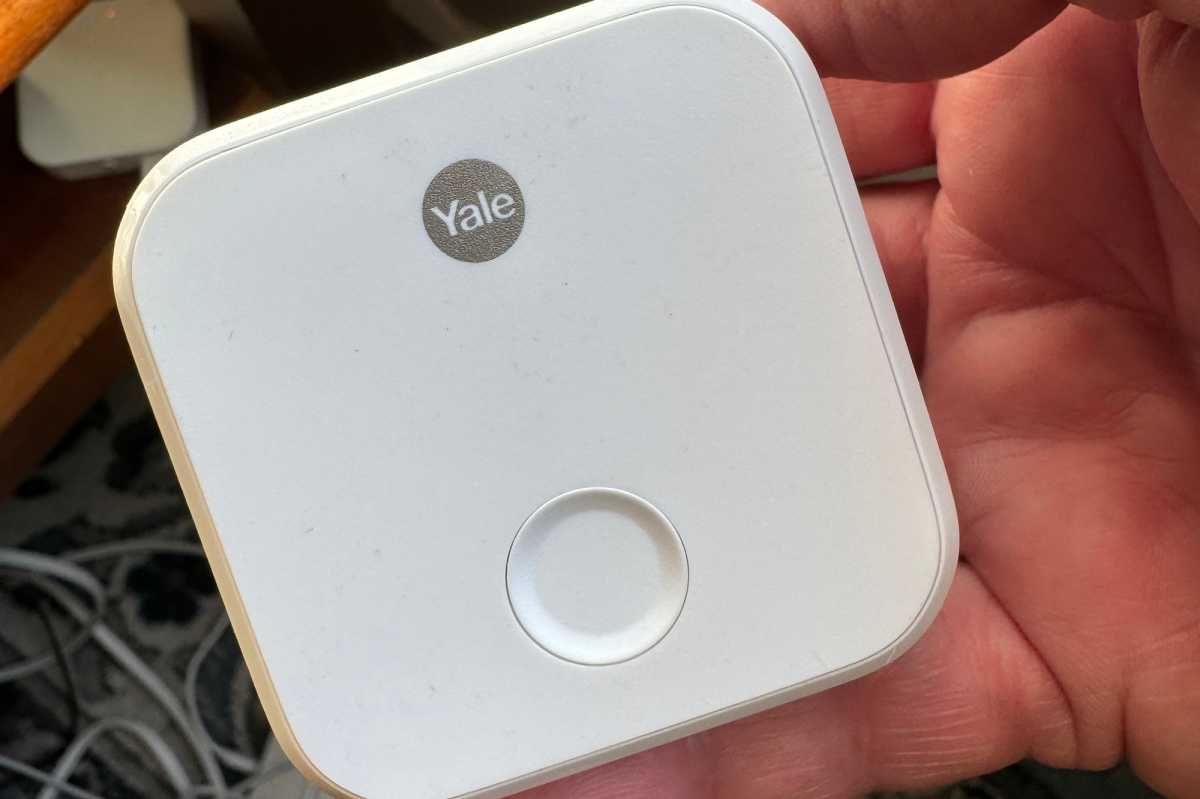
The Yale Connect plugs into any outlet and forms a bridge between the Yale Smart Delivery Box’s Bluetooth radio and your Wi-Fi network.
Michael Brown/Foundry
The lock and keypad are equipped with Bluetooth radios and depend on Yale’s bridge (included) to connect to your Wi-Fi network. This is the same HomeKit-compatible device that Yale uses for its smart deadbolts; fortunately, more than one bridge can coexist in the same environment (and that’s how I tested it, because Yale’s client devices must be within 10 feet of the bridge, and the lock and the box were considerably more than 10 feet apart during my review).
Using the Yale Smart Delivery Box
Whether you buy the Wi-Fi-only version of the Yale Smart Delivery Box, or the model that comes with that connectivity plus a keypad, you can control the box using the Yale Access app, the same software used to control the company’s smart deadbolts. The app will display a large red dot when the box is closed and locked, an open green circle when it’s unlocked, and a notched green circle when it’s both unlocked and open. When the box is unlocked, you can lock and unlock it by touching the solid green or solid red circle respectively.
The app maintains an activity log showing the date and time the box for each instance the box opened and closed, locked and unlocked. and whether that action happened via the app or the keypad. In the latter scenario, the app will identify the person associated with the phone the app is installed on. Should someone get trapped inside the locked box, they can push a large button on the lock itself to unlock the box. Those events are also noted in the activity log.

The Yale Access app showing the Yale Smart Delivery Box’s three states: (R to L) Closed and locked, closed and unlocked, and open and unlocked.
Michael Brown/Foundry
If you have the keypad version reviewed here, you can create PINs for individual users, and you can opt to receive push notifications when those PINs are used. You can also program the app to send you a push notification when the lid is left open.
Like the Bench Sentry Connect delivery box I reviewed in May, 2023, Yale envisions most people leaving the box unlocked until their first parcel is delivered, after which, the box will automatically lock. If you expect to receive more than one delivery per day, you can elect to either leave the box unlocked or, since you’ll receive a push notification each time it’s opened, lock it after what you expect to be the day’s final delivery.
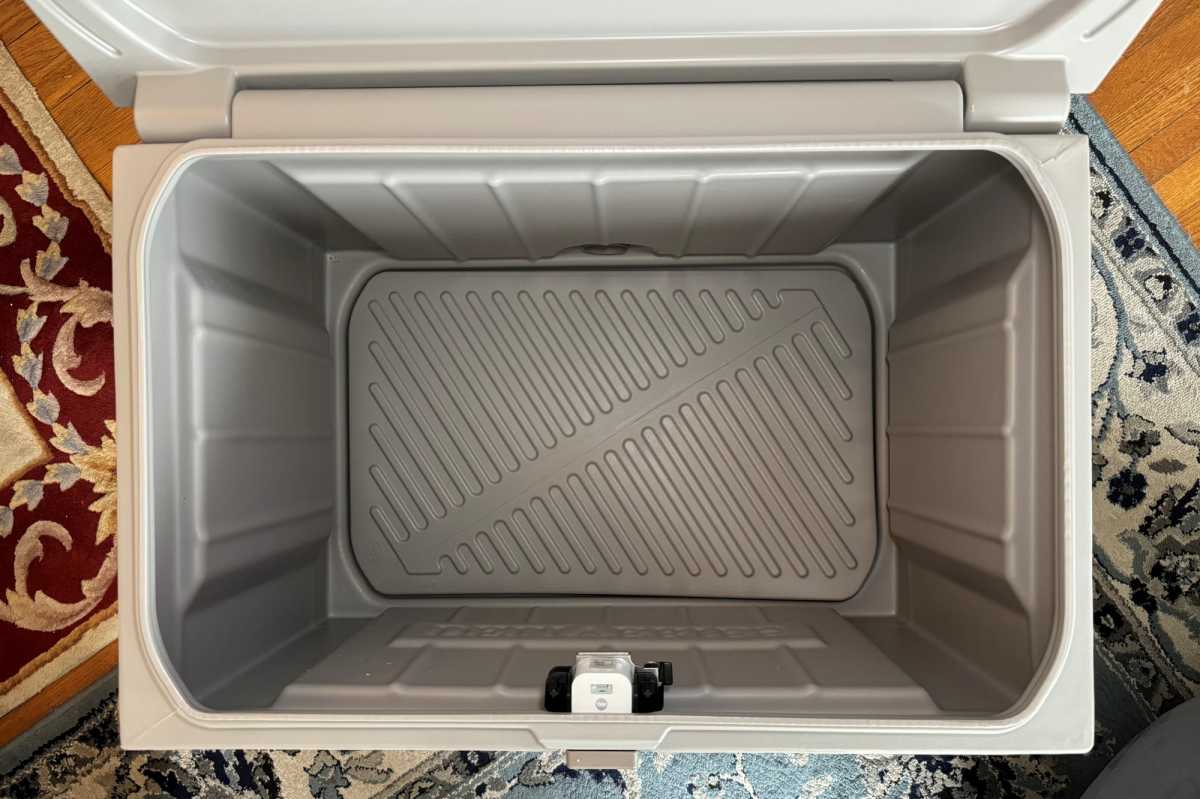
The Yale Delivery Box’s false bottom should help keep packages dry, and you can place a bag of ice under it to keep delivered perishables fresh.
Michael Brown/Foundry
I suppose you could create discrete PINs for Amazon, UPS, and other carriers and include those numbers in your delivery instructions; but unless you create new ones for each delivery and update your instructions accordingly, unscrupulous couriers could open the box anytime they wanted.
All of which highlights one of the best features of the Wi-Fi-connected Loxx Boxx I reviewed in August 2023: That box remains locked 24/7, but you can create unique PINs for each delivery. What’s more, the manufacturer maintains cloud-to-cloud communication with Amazon, UPS, and several other carriers, so that when you enter a package’s tracking number, the Loxx Boxx app automatically creates a one-time-use PIN based on the last four digits of that tracking number. The courier then enters that PIN on the box’s keypad to unlock it and deposit the package. After the lid closes, the lock automatically engages. On the downside, you’ll need a $1.99-per-month subscription to get the full benefit of that product.
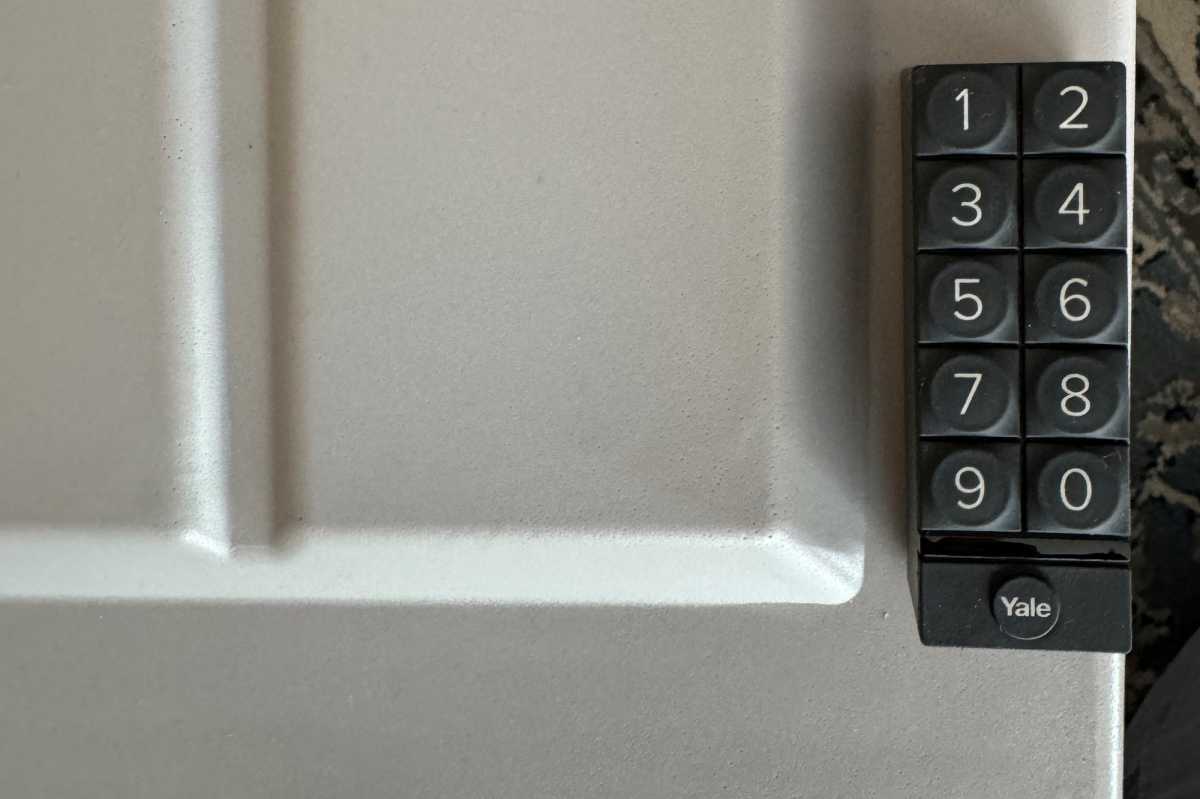
Yale offers this same wireless keypad as an accessory for its smart deadbolts and other locks.
Michael Brown/Foundry
Should you buy the Yale Smart Delivery Box?
There’s a lot to like about the Yale Smart Delivery Box. Its size will accommodate large packages, or lots of small ones; its Wi-Fi connectivity keeps you apprised of its status; its keypad means you don’t always need to have your phone with you to operate it; there are no subscription fees; and it arrives almost fully assembled. It’s a much better product than Genie’s Bench Sentry.
But if you’re looking for the best product in this category, that would be the Loxx Boxx—as of this writing, at least. While it won’t integrate as tightly with the rest of your smart home ecosystem, it does offer something even more useful: direct connectivity to Amazon and the most common delivery companies.
Specifications
- Model reviewed: Yale Smart Delivery Box – Kent (with Wi-Fi and keypad)
- Dimensions:19.0 x 24.6 Wide x 28 inches (HxWxD)
- Capacity: Accommodates packages up to 16 x 22 x 13 inches (HxWxD)
- Primary build material: Plastic resin
- Power source: Lock: Lithium CR2 battery, Keypad: Alkaline AAA batteries
- Connectivity: Bluetooth and Wi-Fi (Yale Connect bridge included)
- App control: Yes, the Yale Access app
- Sends push notifications? Yes, when box is opened, closed, locked, unlocked, etc.
- Logs activity? Yes
- Ecosystem support: Apple HomeKit, limited support for Amazon Alexa, Google Home
- Assembly required? Minimal

